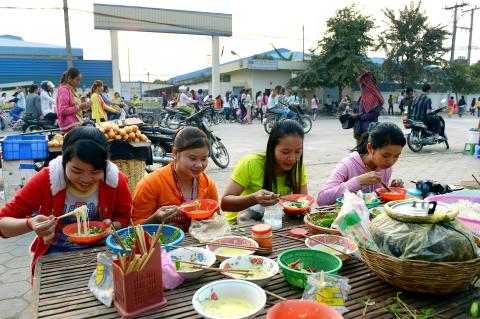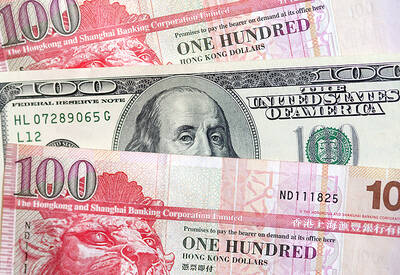As night falls in Phonm Penh, thousands of weary workers stream from textile factories, reflecting the abundance of jobs created by the clothing industry’s desire for cheap labor.
However, as the number of international clothes companies tapping into Cambodia’s workforce grows, so does anger at the low wages and tough conditions that come with such employment in the global garment industry.
Twenty-five-year-old Ou Nin looks exhausted as she describes working for a US clothes brand for just above US$5 a day.

Photo: AFP
“They print on T-shirts. The smell is very unpleasant, it is unbearable,” she said while waiting for the truck to take her home.
Overwork, malnutrition and poor ventilation are to blame for staff fainting in factories since 2010, said Moeun Tola, program manager at the Community Legal Education Centre, which provides advocacy for workers.
“It’s often hot inside these factories. Sometimes they inhale toxic substances,” he said, adding that last year, 1,100 workers are known to have lost consciousness at work while a further 30 fainted in a workshop in mid-January.
With bonuses and overtime, workers can earn an average of US$110 a month — a low salary given Cambodia’s cost of living — forcing many to work beyond the legal limit of 60 hours a week.
A series of strikes point to festering discontent — leaving the big global clothes brands and the factories they subcontract to trade accusations over who is driving salaries down.
Protests by workers have also turned ugly. Three women, employees of Puma supplier Kaoway Sports, were wounded when a gunman opened fire on protesters demanding better working conditions at factories in eastern Svay Rieng Province in February last year.
The shooting prompted Puma, Gap and H&M to express their “deep concern” and urge a thorough investigation.
However, discontent lingers on the factory floor where 400,000 of the 650,000 people employed in the industry work for foreign firms.
Soey Eao, who has worked in the industry for five years, lives in a dormitory behind her factory, paying nearly US$20 a month to share a room with three colleagues.
Hundreds of workers co-exist in similar spartan concrete lodgings, without water or electricity.
“With overtime, I can reach US$78 a month. I work 12 hours a day, sometimes seven days in a row to earn more,” Soey Eao said, adding that she sends one-third of her salary to her family. “I’ve already protested for a raise. I cannot even eat well because I’m trying to put money aside, I just buy the minimum to survive.”
Soey Eao is hopefulthat her situation may change with her union pushing to boost the minimum wage from the US$60 a month to about US$100.
Yet while strikes have turned up the heat on factory owners and international brands, she said that many workers still “do not even know they have rights.”
The International Labour Office, which regularly inspects textile mills in the country, has called for a new industrial agreement between the government, factory owners and unions.
“Clearly there is some room for additional payment,” the group’s Jill Tucker said, adding that after Bangladesh, Cambodia is one of the cheapest places to make garments.
Cambodia’s factory owners say the problem is not their fault and blame the profit margins of foreign brands for driving down wages.
“If our wages were comparable to Vietnam, would investors come to Cambodia? No way,” said Ken Loo, secretary-general of the Garment Manufacturers Association in Cambodia.
“They [buyers] are the ones who set the margin, not us,” he said, warning that if Cambodia raises the minimum wage it would “have to be prepared for what comes after,” hinting that companies may choose to relocate.
However, several big brands contacted by media denied they were cutting wages.
Swedish fashion giant H&M, which in October last year was forced to deny accusations that it encouraged “slave-like” wages at a subcontractor’s factory, said it was not directly responsible for the factories producing its garments.
“H&M does not own any factories and therefore does not set or pay factory workers’ wages,” company spokesman Malin Bjorne said, adding that Cambodian factories produce for many brands.
“The employees at a factory are paid the same wages regardless of which brand they are producing garments for — and regardless of what the final price will be in the store,” Bjorne said.

The US dollar was trading at NT$29.7 at 10am today on the Taipei Foreign Exchange, as the New Taiwan dollar gained NT$1.364 from the previous close last week. The NT dollar continued to rise today, after surging 3.07 percent on Friday. After opening at NT$30.91, the NT dollar gained more than NT$1 in just 15 minutes, briefly passing the NT$30 mark. Before the US Department of the Treasury's semi-annual currency report came out, expectations that the NT dollar would keep rising were already building. The NT dollar on Friday closed at NT$31.064, up by NT$0.953 — a 3.07 percent single-day gain. Today,

‘SHORT TERM’: The local currency would likely remain strong in the near term, driven by anticipated US trade pressure, capital inflows and expectations of a US Fed rate cut The US dollar is expected to fall below NT$30 in the near term, as traders anticipate increased pressure from Washington for Taiwan to allow the New Taiwan dollar to appreciate, Cathay United Bank (國泰世華銀行) chief economist Lin Chi-chao (林啟超) said. Following a sharp drop in the greenback against the NT dollar on Friday, Lin told the Central News Agency that the local currency is likely to remain strong in the short term, driven in part by market psychology surrounding anticipated US policy pressure. On Friday, the US dollar fell NT$0.953, or 3.07 percent, closing at NT$31.064 — its lowest level since Jan.

Hong Kong authorities ramped up sales of the local dollar as the greenback’s slide threatened the foreign-exchange peg. The Hong Kong Monetary Authority (HKMA) sold a record HK$60.5 billion (US$7.8 billion) of the city’s currency, according to an alert sent on its Bloomberg page yesterday in Asia, after it tested the upper end of its trading band. That added to the HK$56.1 billion of sales versus the greenback since Friday. The rapid intervention signals efforts from the city’s authorities to limit the local currency’s moves within its HK$7.75 to HK$7.85 per US dollar trading band. Heavy sales of the local dollar by

The Financial Supervisory Commission (FSC) yesterday met with some of the nation’s largest insurance companies as a skyrocketing New Taiwan dollar piles pressure on their hundreds of billions of dollars in US bond investments. The commission has asked some life insurance firms, among the biggest Asian holders of US debt, to discuss how the rapidly strengthening NT dollar has impacted their operations, people familiar with the matter said. The meeting took place as the NT dollar jumped as much as 5 percent yesterday, its biggest intraday gain in more than three decades. The local currency surged as exporters rushed to